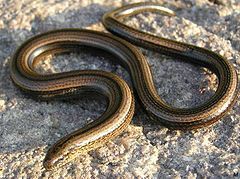Slow worms have done well in north-western Estonia
Photo: Wikipedia
Translation: Liis
| Slow worm | Harilik vaskuss | Anguis fragilis |
Encounters with these "legless lizards” haven’t been uncommon during the last few years . Occasional warm days brought the frozen and stiff creatures out into the sun to get warm. Even though the sluggish slow worms can move in old grass and grassland at a quite considerable speed helped by the grass straws, then out in the open, and particularly where there is a slope, they are rather slow and helpless.
The Estonian name, copper worm, is very apt – the body has a coppery sheen. The female worm’s colour is darker and if it allows one to look at it closely, the dark underbody can be seen. The males are lighter and the belly is light too; the dark stripe on the back disappears on reaching sexual maturity.
Their mating period is towards the end of April and a female may mate with several males. The eggs develop in the female and at the end of August up to a dozen small slow worm babies are born.
An individual that we saw the day before yesterday had recently lost its tail: lizards have the same ability. The lost bit may be up to five centimetres long. The tail regrows but not in its full length. This male was lucky, it escaped only with the loss of its tail..









